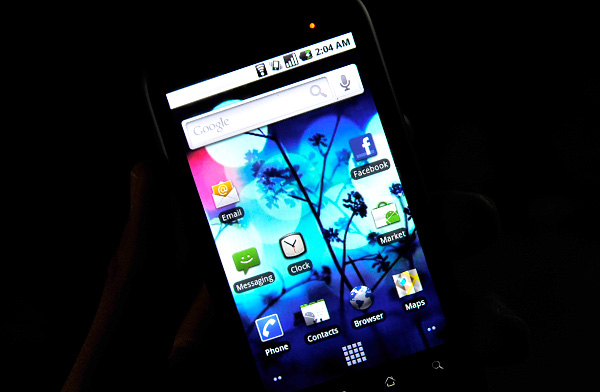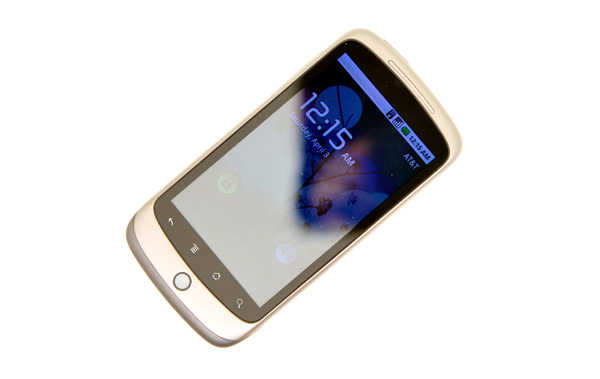Anand's Google Nexus One Review
by Anand Lal Shimpi on April 3, 2010 3:40 AM EST- Posted in
- Smartphones
- Mobile
The Display, My Love, the Display
If there’s one aspect of the Nexus One that makes the iPhone 3GS feel really dated it’s the display. Let’s look at the basic specs:
| Google Nexus One vs. Apple iPhone | |||||
|
Apple iPhone 3GS (ARM Cortex A8)
|
Google Nexus One (Qualcomm Snapdragon QSD8250)
|
||||
| Screen Technology | LCD | Active Matrix OLED | |||
| Screen Diagonal | 3.5" | 3.7" | |||
| Resolution | 320 x 480 | 480 x 800 | |||
| Pixels per Inch | 163 ppi | 252 ppi | |||
For very similar screen sizes (the Nexus One is narrower but longer than the iPhone), Google offers a huge increase in resolution. It makes sense given that the iPhone 3GS is still using the same resolution panel as the first iPhone back in 2007.
Recently Luke Hutchison published an excellent article at Ars Technica explaining the subpixel makeup of the Nexus One’s display. Most display technologies we’re used to reproduce colors by using a combination of red, green and blue. Instead of evenly distributing RGB subpixels across the display, the Nexus One has a combination of RRG or GBB for each pixel. This optimization is put in place most likely to reduce manufacturing cost or increase lifespan of the display.
Either way, you’re not getting complete color data on a per pixel basis. Now I won’t get into the argument of whether or not Google should call it a 480 x 800 display. It technically has that many pixels, it’s just that their makeup is a bit odd.

Google also does some pretty standard tricks to make the display look even more impressive. You get oversaturated colors and the usual trickery you can find in the TV section at Best Buy. Whites on the Nexus One aren't quite white but rather a cool blue and reds are often too red.
Compared to the iPhone, indoors, the Nexus One display is just incredible. If there are two things you could describe the Nexus One display as they would be: high contrast, and sharp. Indoors, and above 50% brightness, it’s honestly the best looking display I’ve ever seen on a smartphone. The colors are ridiculously vibrant and they pop because of the super deep blacks.

It really looks that contrasty.
The AMOLED display has no backlight, and thus it’s far more power efficient to display lots of black than it is to display bright whites. For this reason many of the applications use black backgrounds. For example, here’s the email app in Android vs. the email app in iPhone OS:
|
Google Nexus One
|
Apple iPhone 3GS
|
 |
 |
Given that Android is a fairly mainstream OS and not a pornsite, white text on a black background is generally unexpected. Unexpected, but not more difficult to read. The high resolution and incredibly contrasty AMOLED display make sure of that.

In direct sunlight, the lower part of the picture above is what the Nexus One looks like
Outdoors it’s another story entirely. In direct sunlight, the display is mostly useless at its default brightness settings. With the brightness cranked all the way up it’s still washed out but at least legible. Which brings me to my next point. The auto brightness control on the Nexus One is frustrating.

It automatically adjusts display brightness based on ambient light, but it generally picks a brightness that’s too low for my tastes. I just ended up disabling the automatic control and picked something that was around 50 - 100% brightness depending on what I was doing with the phone. I would like the option to have the auto brightness control pick settings that are a little less conservative.
Touch the Screen
Touchscreens have gotten much better over the past couple of years since the iPhone’s introduction. The Nexus One’s touchscreen is very close to as responsive as the iPhone’s but with some annoying issues. There are some situations where holding the Nexus One in one hand and swiping with my thumb won’t let me swipe between screens, and other similar accuracy issues. Getting the home bar buttons to recognize taps is also a pain at times. The touchscreen is definitely usable, just not as good as the iPhone's.










95 Comments
View All Comments
coolVariable - Saturday, April 10, 2010 - link
Oh, STFU you fanboy.1. No calendar sync. Buggy Contact sync (e.g. contact pics, birthdays, ...). Buggy e-mail sync (just stops randomly). STFU since you have no clue what you are talking about.
3. A phone that can't even make calls. GREAT!!!! I don't fvcking care what the reason for the problem is. A $600 phone should be able to make a fvcking phone call!!!!!!
4. Love your little walled garden? Why don't you get an Apple phone if you are soooooo in love with a company locking down the functionality of your phone???????? Anand bad-mouthes Apple for its walled garden and ignores this "walled garden"???
5. Walled garden! Walled garden! Walled garden! Walled garden!
All of the above are pretty big problems with android per se and the Nexus One specifically!
It's pathetic that they weren't even mentioned during this review.
Not to mention the myriad of other (often cosmetic) problems and bugs with android (e.g. contact sort, etc).
And a tech-savy reviewer would have also mentioned the hypocrisy that you need to "jailbreak" android to do a lot of things. While that is fine, it pretty hypocritical that you can't "un-jailbreak" the Nexus One for a warranty exchange (something that is pretty easy to do with the iphone).
ruzveh - Sunday, April 11, 2010 - link
Anand nice article and m also looking fwd to buy one phone in near future from GoogleFrom my point of view is that 1GHz processor with 65nm is draining the battery life. Imagine if u insert 1GHz processor with 32nm (todays std) or even less will boost ur battery life almost double. I dont understand so called this chip company why not jumping onto 32nm bandwagon or to somewhat 25nm or even less?
i just feel these cos r wasting so called resources and time for money / profits. Dont they knw resources r limited and so purchasing power.
Thats secondary thing. Ohh what? r u thing i forgot to mention primary issue? lolz
Well its obvious.. Innovation in Battery power. What i hate in mobiles are speed and battery life for which i m ending up using my cell ph for only calls & ofcourse sms since past 8yrs 6630 and not willing to change untill they come up with good phones..
coming back to battery life i really dont understand why these cos r not doing something in batter life when there is lot of room for improvement in it like todays model feature only 1500mah battery power wheres a small pencil cell can go all the upto 3000mah or even more. We definitely want to see double the capacity then what they r featuring today.. Anand can u clear me on this prospect?
I am v much sure if v give proper attention in this area we can do wonders. Comon someone has to do something sooner or the later...
7.saturnine - Wednesday, April 14, 2010 - link
I don't understand the trend of putting as few physical buttons on a device as possible. How do you skip or pause music when the device is in your pocket? Pull it out, unlock the screen, find the music app & press the button? That is ridiculous.On my HTC Touch (WinMo6) it has hardly any buttons either, but at least one programmable physical button (that I have programmed to open the camera from any app I am in) & a directional pad/enter button. Sometimes I just like using the directional pad to go through menus & select something rather than moving my thumb all the way up the screen. Yes that sounds incredibly lazy, but aren't these devices all about ease of use, simplicity & speed? Programmable hardware buttons do just that. They are focusing too much on the aspect of a touch screen.
Affectionate-Bed-980 - Thursday, April 15, 2010 - link
This seems to be a forgotten thing. I spent 2 hrs playing around writing probably pages worth of notes just to test it out on Android.You say the iPhone lackED it? I have an iPod Touch 1G and I guess I'm used to multitouch by now, but how long did it take for Apple to add it? I notice how ridiculously fast I can type on it and not skip words/keys. On Android, it's a totally different thing.
A few tips from me as I've investigated this for a long time and I've made cries out on Android forums with very little sympathy:
1) HTC's IME keyboard that is modded on XDA is a LOT better. The developer tried to implement a little pseudo multitouch so it is more used to you pressing the next key before releasing the previous. This is a HUGE issue with the space bar and if you use the stock android keyboard, you're going to be skipping words like mad if you type too fast.
2) Smart Keyboard Pro has multitouch. It also features a debug mode that you can look at your touch points. It definitely picks up multitouch flawlessly. Is it as good as the iPhone keyboard? Somehow I was still typing faster on my iPod than on my Android phone with Smart Keyboard Pro.
However, with the mods the modders have made on the HTC IME Keyboard, I've decided to stick with it. It's getting better and it's handling multitouch somewhat even though it's not a true multitouch implementation.
But you're right. It's night and day without multitouch. For people who haven't used the iPhone enough, they fail to appreciate the keyboard. Most people just go "Oh I type fine on my Nexus One. I type pretty fast." Obviously you can't type THAT fast if it lacks multitouch. Maybe they should look at what "fast" means on the iPhone :D
rossmandor - Monday, August 30, 2021 - link
nice one